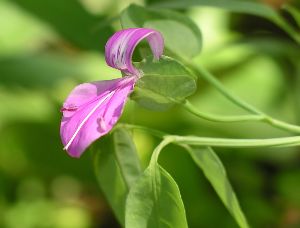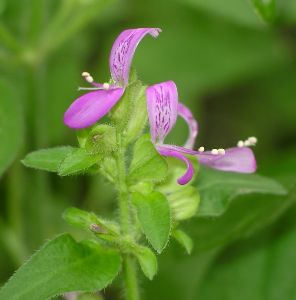Foldwing
by Valerie (May 24, 2001)
revised October 25, 2003
Sometimes it is very easy to discern the identity of a plant and obtain more information about it. A lot of the time I just rely on memory to make the first identification, then follow up with checking field guides, gardening books and web sites. I always try to double check spelling and common names, since these vary considerably throughout different regions of the country. Generally I can find out quite a bit about any plant we grow, but not always.

The subject of this article was bought at a local nursery, with little regard to species name, since I didn't even know if it would do well or not. It has turned out to be a wonderful garden plant. With no name to go by, I found out nothing beyond my own observations about this flower for at least two years. I wrote this article anyway, but my initial tentative identification was incorrect. Thanks to another gardener here in Austin, I have now identified not only my original plant, but a closely related native wildflower which we also grow. Our mystery plant is called foldwing (Dicliptera resupinata or Justicia resupinata). It is a native of Arizona, New Mexico, and northern Mexico. This gives it a couple of its other common names, which are Arizona foldwing and Arizona dicliptera. It is also called twin seed. Although native to the area west of us, the plant does very well in our gardens. It freezes back to the ground in the winter, but has always come back, even if only feebly after an especially hard freeze. Foldwing grows to about two feet tall and spreads just as wide. It produces numerous sprawling branches from the ground with narrow, lance-shaped smooth leaves. The flowers are produced on the end of separate stems, usually in groups of three, but they don't all blossom at the same time. The two obvious petals appear out of a flattened sheath, which later turns papery brown and contains the seeds. Foldwing seeds very easily, but our plants don't seem to produce all that much. I've tried to collect the seeds and often only find one or two after the flower has produced dozens of blossoms. Once a seed does germinate, it is quite hardy, and one of our plants is actually growing in a hole in a rock. I assume its roots have found their way all the way to the ground below.
I collected a few seeds and tossed them into a garden. The following year, an unidentified plant appeared (not unusual in our gardens) and when it bloomed, I realized what it was, but still didn't know the name because it is not listed in any of the Texas wildflower field guides at my disposal. This plant is called lavender dicliptera (Dicliptera brachiata) or branched foldwing. It is native throughout the southern states, from Texas to Florida, and has several other names, both common and Latin synonyms. In our area, false mint seems to be the preferred moniker, while in Florida, wild mudwort prevails. Synonyms include Dicliptera glandulosa, Diapedium brachiatum, Diapedium attenuatum, and Justicia brachiata. Although not widespread, where it does occur, dicliptera tends to be prolific. Unlike many perennials we have raised from seed, it grew quickly the first year and produced flowers. By the second year the plant was over a foot tall and sprawling, producing many small pink blossoms in the late summer. Shade does not deter its flowering and it is a welcome addition to our gardens. |
 In an interesting coincidence, shortly after I bought a small foldwing plant at a local nursery, I found a tiny version of it growing in a natural area here in Austin. The plant was similar to the ones growing in our yard but smaller. It was in a shaded area, as are ours and they seemed to do well without too much sun or watering.
In an interesting coincidence, shortly after I bought a small foldwing plant at a local nursery, I found a tiny version of it growing in a natural area here in Austin. The plant was similar to the ones growing in our yard but smaller. It was in a shaded area, as are ours and they seemed to do well without too much sun or watering.